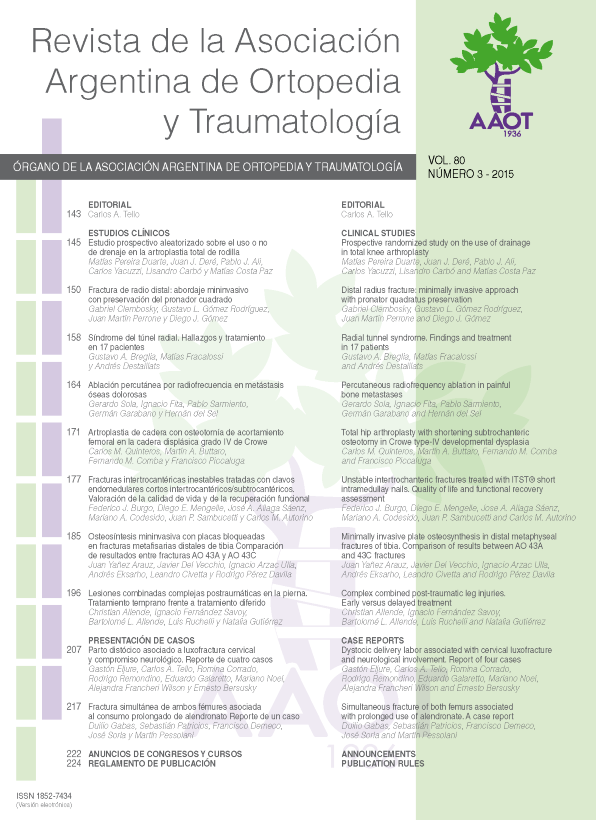Unstable intertrochanteric fractures treated with ITST short intramedullary nails. Quality of life assessment and functional recovery.
Main Article Content
Abstract
Downloads
Metrics
Article Details

This work is licensed under a Creative Commons Attribution-NonCommercial-ShareAlike 4.0 International License.
Manuscript acceptance by the Journal implies the simultaneous non-submission to any other journal or publishing house. The RAAOT is under the Licencia Creative Commnos Atribución-NoComercial-Compartir Obras Derivadas Igual 4.0 Internacional (CC-BY-NC.SA 4.0) (http://creativecommons.org/licences/by-nc-sa/4.0/deed.es). Articles can be shared, copied, distributed, modified, altered, transformed into a derivative work, executed and publicly communicated, provided a) the authors and the original publication (Journal, Publisher and URL) are mentioned, b) they are not used for commercial purposes, c) the same terms of the license are maintained.
In the event that the manuscript is approved for its next publication, the authors retain the copyright and will assign to the journal the rights of publication, edition, reproduction, distribution, exhibition and communication at a national and international level in the different databases. data, repositories and portals.
It is hereby stated that the mentioned manuscript has not been published and that it is not being printed in any other national or foreign journal.
The authors hereby accept the necessary modifications, suggested by the reviewers, in order to adapt the manuscript to the style and publication rules of this Journal.
References
mortality after hip fracture surgery. Injury 2014;46(4):713-8.
2. Haleem S, Lutchman L, Mayahi R, Grice JE, Parker MJ. Mortality following hip fracture: trends and geographical variations over
the last 40 years. Injury 2008;39:1157-63.
3. Adams CI, Robinson CM, Court-Brown CM, McQueen MM. Prospective randomized controlled trial of an intramedullary nail
versus dynamic screw and plate for intertrochanteric fractures of the femur. J Orthop Trauma 2001;15:394-400.
4. Aktselis I, Kokoroghiannis C, Fragkomichalos E, Koundis G, Deligeorgis A, Daskalakis E, et al. Prospective randomised
controlled trial of an intramedullary nail versus a sliding hip screw for intertrochanteric fractures of the femur. Int Orthop
2014;38:155-61.
5. Barton TM, Gleeson R, Topliss C, Greenwood R, Harries WJ, Chesser TJ. A comparison of the long gamma nail with the sliding
hip screw for the treatment of AO/OTA 31-A2 fractures of the proximal part of the femur: a prospective randomized trial. J Bone
Joint Surg Am 2010;92:792-8.
6. Parker MJ, Handoll HH. Gamma and other cephalocondylic intramedullary nails versus extramedullary implants for extracapsular
hip fractures in adults. Cochrane Database Syst Rev 2008:CD000093.
7. Ahrengart L, Tornkvist H, Fornander P, Thorngren KG, Pasanen L, Wahlström P, et al. A randomized study of the compression
hip screw and Gamma nail in 426 fractures. Clin Orthop Relat Res 2002;401:209-22.
8. Bhandari M, Schemitsch E, Jonsson A, Zlowodzki M, Haidukewych GJ. Gamma nails revisited: gamma nails versus compression
hip screws in the management of intertrochanteric fractures of the hip: a meta-analysis. J Orthop Trauma 2009;23:460-4.
9. Davis TR, Sher JL, Horsman A, Simpson M, Porter BB, Checketts RG. Intertrochanteric femoral fractures. Mechanical failure
after internal fixation. J Bone Joint Surg Br 1990;72:26-31.
10. Albareda J, Laderiga A, Palanca D, Paniagua L, Seral F. Complications and technical problems with the gamma nail. Int Orthop
1996;20:47-50.
11. Rosenblum SF, Zuckerman JD, Kummer FJ, Tam BS. A biomechanical evaluation of the Gamma nail. J Bone Joint Surg Br
1992;74:352-7.
12. Herrera A, Domingo J, Martinez A. Results of osteosynthesis with the ITST nail in fractures of the trochanteric region of the
femur. Int Orthop 2008;32:767-72.
13. Baumgaertner MR, Curtin SL, Lindskog DM, Keggi JM. The value of the tip-apex distance in predicting failure of fixation of
peritrochanteric fractures of the hip. J Bone Joint Surg Am 1995;77:1058-64.
14. Callaghan JJ, Dorr LD, Engh GA, Hanssen AD, Healy WL, Lachiewicz PF, et al. Prophylaxis for thromboembolic disease:
recommendations from the American College of Chest Physicians--are they appropriate for orthopaedic surgery? J Arthroplasty
2005;20:273-4.
15. Escobar A, Quintana JM, Bilbao A, Azkárate J, Güenaga JI. Validation of the Spanish version of the WOMAC questionnaire
for patients with hip or knee osteoarthritis. Western Ontario and McMaster Universities Osteoarthritis Index. Clin Rheumatol
2002;21:466-71.
16. Enneking WF, Dunham W, Gebhardt MC, Malawar M, Pritchard DJ. A system for the functional evaluation of reconstructive
procedures after surgical treatment of tumors of the musculoskeletal system. Clin Orthop Relat Res 1993;286:241-6.
17. Han CD, Lee YH, Yang KH, Yang IH, Lee WS, Park YJ, et al. Relationship between distal screws and femoral arteries in closed
hip nailing on computed tomography angiography. Arch Orthop Trauma Surg 2013;133:361-6.
18. Wallace W. The increasing incidence of fractures of the proximal femur: an orthopaedic epidemic. Lancet 1983;1(8339):1413-4.
19. Herrera A, Domingo LJ, Calvo A, Martínez A, Cuenca J. A comparative study of trochanteric fractures treated with the Gamma
nail or the proximal femoral nail. Int Orthop 2002;26:365-9.
20. Lichtblau S. Treatment of hip fractures in the elderly. The decision process. Mount Sinai J Med 2002;69:250-60.
21. Utrilla AL, Reig JS, Munoz FM, Tufanisco CB. Trochanteric gamma nail and compression hip screw for trochanteric fractures:
a randomized, prospective, comparative study in 210 elderly patients with a new design of the gamma nail. J Orthop Trauma
2005;19:229-33.
22. Stannard JP, Bankston L, Futch LA, McGwin G, Volgas DA. Functional outcome following intramedullary nailing of the
femur: a prospective randomized comparison of piriformis fossa and greater trochanteric entry portals. J Bone Joint Surg Am
2011;93:1385-91.

